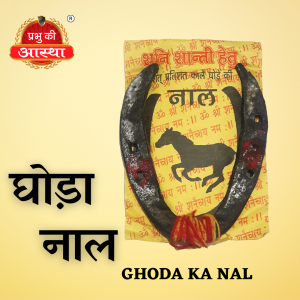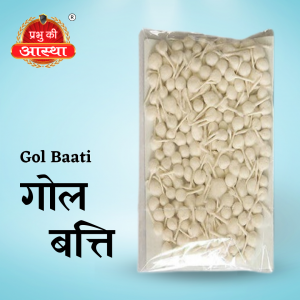PUJA ITEMS
-
 Read more
Read moreGhee batti, also known as ghee diya, is a type of lamp used in Hindu religious ceremonies, particularly during puja or worship. It is made by melting ghee, which is clarified butter, and pouring it into a small clay or metal container with a cotton wick. The wick is lit and the ghee burns slowly, producing a bright flame and a pleasant aroma. Ghee is believed to be a pure substance that is offered to deities as a symbol of purity and devotion. Lighting a ghee batti is considered to bring good luck and blessings, and is a common practice during festivals and other auspicious occasions. The flame of the ghee batti is believed to represent the divine light of the deity being worshipped, and is used to purify the environment and create a sacred atmosphere. Ghee batti can also be used for aromatherapy, as the burning ghee releases a pleasant scent that is said to have a calming effect on the mind and body. In addition to its religious and spiritual significance, ghee batti is also used in traditional medicine for its therapeutic properties. It is believed to have a cooling effect on the body and can be used to treat various ailments such as inflammation, sore throat, and cough. Ghee batti remains an important part of Hindu culture and tradition, and is used in many homes and temples for its spiritual, therapeutic, and aromatic properties.
-
 Read more
Read moreGhee batti, also known as ghee diya, is a type of lamp used in Hindu religious ceremonies, particularly during puja or worship. It is made by melting ghee, which is clarified butter, and pouring it into a small clay or metal container with a cotton wick. The wick is lit and the ghee burns slowly, producing a bright flame and a pleasant aroma. Ghee is believed to be a pure substance that is offered to deities as a symbol of purity and devotion. Lighting a ghee batti is considered to bring good luck and blessings, and is a common practice during festivals and other auspicious occasions. The flame of the ghee batti is believed to represent the divine light of the deity being worshipped, and is used to purify the environment and create a sacred atmosphere. Ghee batti can also be used for aromatherapy, as the burning ghee releases a pleasant scent that is said to have a calming effect on the mind and body. In addition to its religious and spiritual significance, ghee batti is also used in traditional medicine for its therapeutic properties. It is believed to have a cooling effect on the body and can be used to treat various ailments such as inflammation, sore throat, and cough. Ghee batti remains an important part of Hindu culture and tradition, and is used in many homes and temples for its spiritual, therapeutic, and aromatic properties.
-
 Read more
Read moreGhee batti, also known as ghee diya, is a type of lamp used in Hindu religious ceremonies, particularly during puja or worship. It is made by melting ghee, which is clarified butter, and pouring it into a small clay or metal container with a cotton wick. The wick is lit and the ghee burns slowly,…
-
 Read more
Read moreGhee batti, also known as ghee diya, is a type of lamp used in Hindu religious ceremonies, particularly during puja or worship. It is made by melting ghee, which is clarified butter, and pouring it into a small clay or metal container with a cotton wick. The wick is lit and the ghee burns slowly,…
-
 Read more
Read moreGhee batti, also known as ghee diya, is a type of lamp used in Hindu religious ceremonies, particularly during puja or worship. It is made by melting ghee, which is clarified butter, and pouring it into a small clay or metal container with a cotton wick. The wick is lit and the ghee burns slowly,…
-
 Read more
Read moreGhee batti, also known as ghee diya, is a type of lamp used in Hindu religious ceremonies, particularly during puja or worship. It is made by melting ghee, which is clarified butter, and pouring it into a small clay or metal container with a cotton wick. The wick is lit and the ghee burns slowly,…
-
 Read more
Read moreEkanshi Nariyal, also known as the “one-eyed coconut,” is a rare and sacred coconut that is considered to be a symbol of good luck and prosperity in Hinduism. It is called “one-eyed” because it has only one of the three black spots or “eyes” that are typically found on coconuts. Ekanshi Nariyal is used in…
-
 Read more
Read morePuja Attar is a type of aromatic oil used in Hindu worship and rituals. It is derived from natural plant sources and is believed to have spiritual and medicinal properties. Puja Attar is typically made from a blend of various essential oils, herbs, and flowers that are carefully distilled or extracted to create a unique fragrance.
Puja Attar is an essential component of Hindu worship and is used in various rituals and ceremonies. It is often applied to the skin or used in a diffuser to create a sacred and uplifting atmosphere during prayer and meditation. The fragrance is believed to have a purifying effect on the mind and soul and is said to promote a sense of calm and relaxation.
There are many different types of Puja Attar, each with its own unique properties and fragrance. Some of the most popular types include Sandalwood Attar, Rose Attar, Jasmine Attar, and Nag Champa Attar. Each type of Attar is believed to have specific spiritual and medicinal benefits and is used for different purposes in Hindu worship and rituals.
In addition to its use in Hindu worship, Puja Attar is also used in Ayurvedic medicine for its therapeutic properties. It is believed to have a range of healing benefits, including promoting relaxation, reducing stress and anxiety, and improving mental clarity and focus.
In conclusion, Puja Attar is a type of aromatic oil used in Hindu worship and rituals. It is derived from natural plant sources and is believed to have spiritual and medicinal properties. Puja Attar is an essential component of Hindu worship and is used to create a sacred and uplifting atmosphere during prayer and meditation. It is also used in Ayurvedic medicine for its therapeutic properties.
-
 Read more
Read moreGanga Mritika: Meaning and Usage in Hindu Rituals Ganga Mritika, also known as Ganga Mitti or Ganga soil, is the sacred earth collected from the banks or bed of the holy River Ganga. It holds immense religious significance in Hinduism, as the Ganga is considered not just a river but a divine mother and purifier…
-
 Read more
Read moreGhee batti, also known as ghee diya, is a type of lamp used in Hindu religious ceremonies, particularly during puja or worship. It is made by melting ghee, which is clarified butter, and pouring it into a small clay or metal container with a cotton wick. The wick is lit and the ghee burns slowly,…
-
 Read more
Read moreGhode Ke Naal, also known as the horse shoe, is considered a sacred object in Hinduism and is believed to have protective properties. It is a traditional symbol of good luck and is often hung over the entrance of homes, shops, and other buildings to ward off evil spirits and bring good fortune. The horseshoe…
-
 Read more
Read moreRui Jyot Baati is a traditional Indian lamp made of cotton wicks and ghee or oil. It is commonly used in Hindu households for various auspicious occasions and religious ceremonies.
The lamp is made by rolling cotton wicks in ghee or oil and placing them in a small clay or metal lamp. The wicks are then lit, producing a bright flame that illuminates the surrounding area. The lamp is considered to be a symbol of divine light and is believed to bring good fortune and prosperity.
Rui Jyot Baati is often used in puja rituals and is considered to be an essential part of the worship. It is believed that lighting the lamp creates a positive and sacred environment that helps to connect with the divine.
In addition to its spiritual significance, Rui Jyot Baati is also used for its aesthetic value. The lamp creates a warm and inviting atmosphere and is often used to decorate homes during festivals and other celebrations.
Overall, Rui Jyot Baati holds great cultural and spiritual significance in Hinduism and is an integral part of many religious and cultural traditions.

